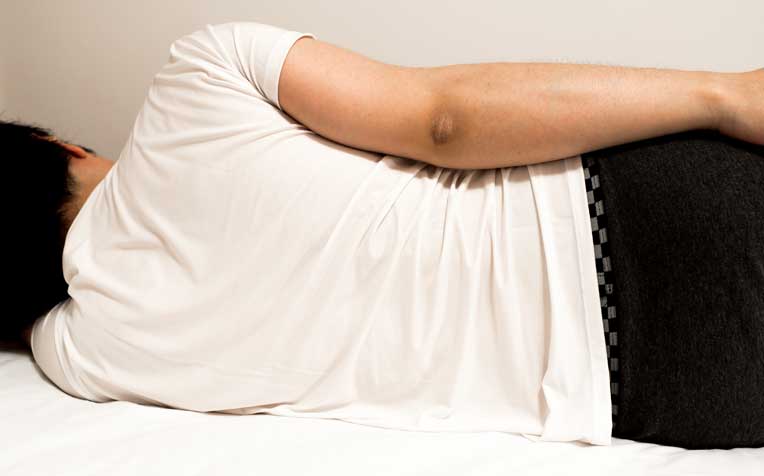Non-English translations are machine-generated; verify independently for
potential
inaccuracies.
Let us help you find what you're looking for.
Popular Searches
Back Pain: Symptoms, Diagnosis, Treatment

Lying on your side can help to relieve pressure on your spine.
Do you suffer from back pain? Learn about the symptoms of back pain and how to diagnose and treat it.
Symptoms
- There’s a deep, dull or burning pain in one area of the back, or it travels down the legs.
- The pain can come from the bones, joints, muscles, nerves or organs.
- There’s numbness, burning or a pins-and-needles sensation in the legs.
- You find it difficult performing regular daily activities such as climbing stairs.
- The pain lasts a long time, and is not relieved by standard methods of medical management.
Diagnosis
- X-rays check for fractures or other problems in the bone.
- CT Scans have a similar function as X-rays but show greater detail.
- An MRI detects conditions like slipped discs, nerve root compression, infections of the bone or spinal canal, fractures or tumours.
- Nerve Conduction Study (NCS) or Electromyogram (EMG) are nerve tests that can help to determine the presence of nerve abnormality and to distinguish between nerve root and muscle disease.
Treatment
- Simple painkillers such as paracetamol and anti-inflammatory medications; if these don’t work, try non-steroidal anti-inflammatory medication (NSAIDs) and Cox-2 inhibitors which are easier on the stomach.
- Supervised physiotherapy with traction and heat therapy, followed by exercise programmes.
- Radio frequency ablation, which generates heat around a nerve and destroys its ability to transmit pain.
- Spinal cord stimulation, an implantable device that stimulates the spinal cord electrically to block the transmission of pain.
- Spinal injections, including epidural steroidal injections and nerve blocks, which are injections of medication near the nerves.
- Surgery is recommended if conservative treatment as well as interventional pain procedures are not helpful. Let your doctor recommend the most suitable treatment.
Prevention
- Regular exercises can prevent low back pain. Abdominal and back strengthening exercises maintain muscle tone. At work, make sure your office furniture is comfortable and that you sit at your work table correctly. Ensure that you always watch your posture.
Ref. T12
Contributed by
Related Articles
Conditions & Treatments
Public Events
02 Jul 2025
Programmes
KKH Antenatal Programme
1-Day Intensive Course KKH Patient: $306 Non-KKH Patient: $326; 4-Week Course KKH Patient: $240 Non-KKH Patient: $296
Learn More
03 Jul 2025
Talks
Health Talk: Nutrition Demonstration @ SHP-Bedok
Free, no registration required. Please walk in to clinic at specified date and time.
Learn More
04 Jul 2025
Talks
Health Talk: Weaning Diet @ SHP-Tampines North
Free, no registration required. Please walk in to clinic at specified date and time.
Learn More
05 Jul 2025
Workshop
KKH Child and Infant CPR Workshop
On-site
•
$25 per pax for KK Parenting Club Member; $35 per pax for Non-member
Learn More
Get the Health Buddy App
© 2025 SingHealth Group. All Rights Reserved.

















 Get it on Google Play
Get it on Google Play